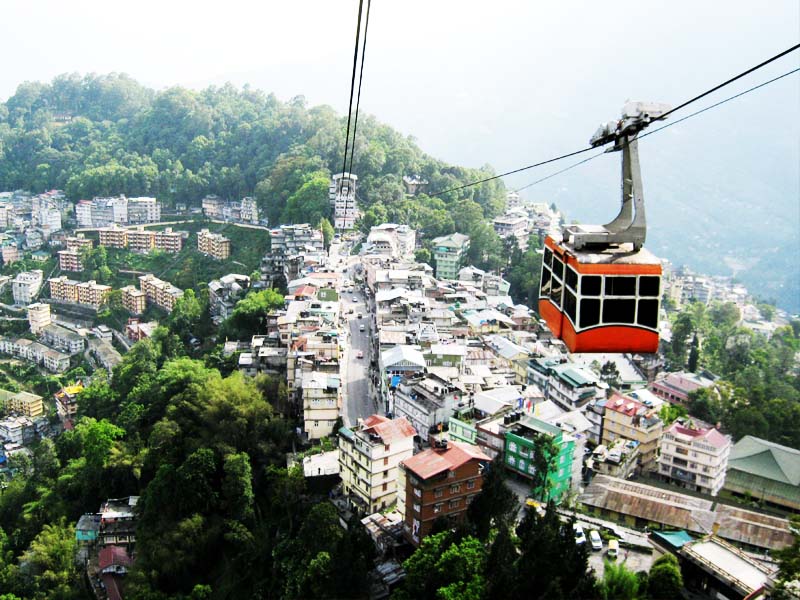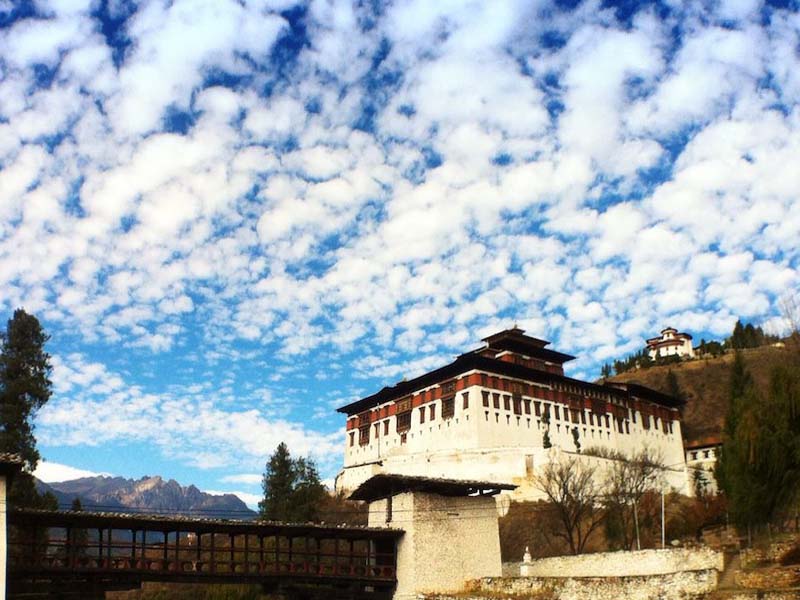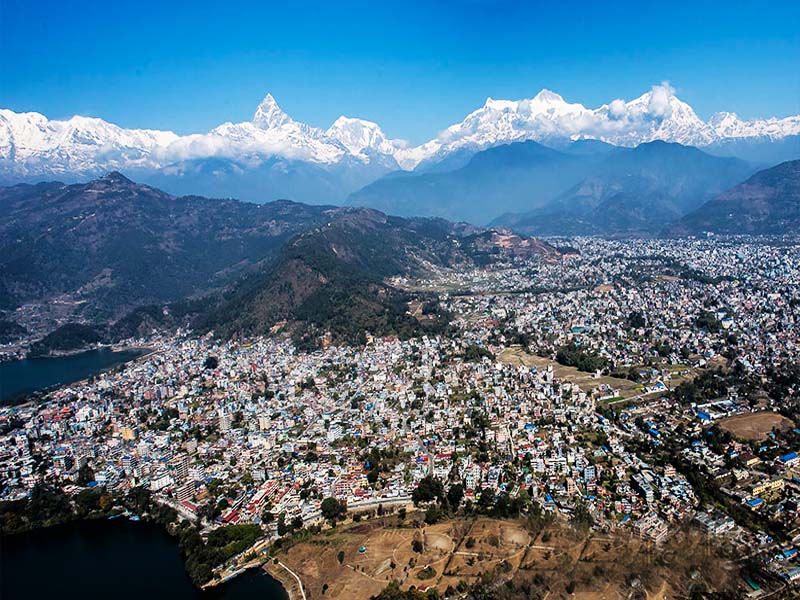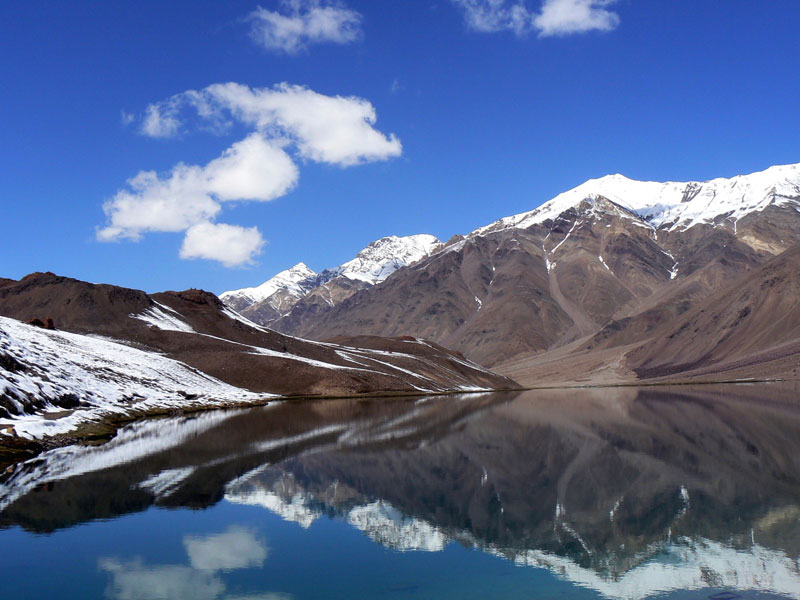DAY 01 : KOLKATA - BAGDOGRA DARJEELING (94 KM 3-4 HRS)
After breakfast check out hotel then transport to domestic airport & Open
arrival in Bagdogra Airport meet and welcome you by our Guide at the airport
and then transfer you on a journey drive through picturesque tea gardens to
the world renowned hill station, Darjeeling. Perched on an altitude of
2134m, Darjeeling is set amidst a majestic backdrop of the great Himalayan
peak of Kanchenjunga (3rd highest peak in the world at 8586m) and is
regarded as the Queen of East India. After dinner, free at leisure to visit
the local bazaar.
DAY 02 : DARJEELING SIGHTSEEING
Depart hotel at about 4am for Tiger Hill (2685m) for sun rising view and a
panoramic view of the spectacular snow-clad mountain peaks of the Himalayan
Range.Visit to the Ghoom Monastery, built in 1850 by Lama Sharb, which
enshrines a 15ft. Statue of Maitreya Buddha After which, back to hotel for
your breakfast and then visit the Himalayan Zoological Park. The zoo serves
as a breeding center for snow leopards and red pandas, as well as a home for
mountain yaks, Himalayan black bears and Siberian Tigers. Visit the
Himalayan Mountaineering Institute, located within this zoo, which was
founded in 1954 to commemorate history's first successful conquest of Mt.
Everest in 1953 by 'Darjeeling's son, Tenzing Norgay and Sir Edmund Hillary.
Then Then proceed to Tibetan Refugee Center.
DAY 03 : DARJEELING PELLING (4-5 HRS)
After breakfast drive to Pelling on the way, perched on top of the hill
rising between the Rathong River and the Rangit River, it provides
breathtaking views of the scenery below. On arrival visit sanga cholin
Monastry which is one of the oldest monastery in west Sikkim over night at
Hotel.
DAY 04 : PELLING
After breakfast Proceed to sight seen on the way passing by Rimbi Falls and
Kanchenjunga Falls visit the placid & clear Khecheopari, means Wishing.After
lunch, visit the Pemayangtse Monastery, one of the oldest and important
monasteries in Sikkim. Pamayantse Monastery is situated less than a
kilometer from Pelling. The monastery houses numerous religious idols and
other objects of worship, most of which are priceless because of their
antiquity. Pelling is indeed a nice place away from the hustle, bustle and
noise. Here, you can breathtaking view of Mt Kanchenjunga in the clear
day.and Rabdanste Ruins. Rabdanste Ruins are now being preserved by the
Archaeological Survey of India and have been declared as a monument on
completed drive to Pelling over night at Pelling.
DAY 05 : PELLING GANGTOK (5-HRS)
Bid farewell to Pelling and leave for Gangtok, the capital of Sikkim. Tucked
away in the clouds, Gangtok is spread out on a ridge 1520m above sea level,
and looks something out of a fairy tale with houses precariously balanced on
the slopes of steep hills. Apart from the gorgeous view of deep valleys,
waterfalls and snow-capped mountain ranges that separate from neighbouring
Tibet, Bhutan and Nepal. En-route, visit Temi tea garden on arrival check
inn to hotel evening free and easy over night in hotel.
DAY 06 : GANGTOK TSOMGO LAKE (3 HRS) GANGTOK
After breakfast, drive to Tsomgo Lake, also means as “The Source of the
Lake” (3,780m). The lake derives its water from melting snows off the
surrounding mountains, which is one of the famous sacred lakes in Sikkim,
situated near the borders of Indo-Tibet and drive Back to Gantok.
DAY 07 : GANGTOK LACHUNG (6~7-HRS)
Today, we leave for North district of Sikkim to a small village, Lachung
(2,400m). This spectacular drive will take about 6-7 hrs (lunch en-route).
If weather is clear, you’ll see the magnificent range of the third highest
mountain in the world, Kanchenjunga and some wild orchids blooming (during
spring) on the way. Arrive Lachung in the late afternoon and check in at a
lodge. (Please be reminded that the facilities here are very basic).
DAY 08 : LACHUNG YUMTHANG (1 - HRS) EX GANGTOK (6~7-HR DRIVE)
After breakfast, we leave for Yumthang (3,500m) excursion. This panoramic
drive will bring you to the Valley of Flowers which consists of about 36
species of rhododendrons, primulas and other spectacular alpine wild
flowers. Yaks and dzos can be seen grazing on the meadows. On way back, walk
across the Lachung Chu and have a dip in a hot spring (swimming costumes
needed). If not, just enjoy the scenic surrounding. Back to Lachung for
lunch after lunch drive to Gangtok.
DAY 09 : GANGTOK - PHONTSHOLING (INDIA - BHUTAN BORDER)
After breakfast, we leave for Phontsholing India-Bhutan border line area on
arrival at Jaigaow finish India immigration then check inn to Bhutan.
DAY 10 : PHONTSHOLING – THIMPU
After breakfast check out then drive to Capital of country (Thimpu) en-route
visit Dzandropeli monastery & Kharkandi monastery on completed drive to
Chuka for lunch after lunch drive to Thimpu on arrival check in to hotel
afternoon visit.
Memorial Chorten: This landmark of Thimphu was built in 1974 in the memory
of third King, Jigme Dorji Wangchuk, who is popularly regarded as Father of
Modern Bhutan. It is a four-storey tall white building, containing statues
and iconography of deities from complex tantric teachings and serves as an
important place of worship for Thimphu residents, as well as from other
parts of the country.
Buddha Dordema: Early in the morning drive to the Buddha point to take
beautiful shot of Buddha and the valley. The big statue of sitting Buddha is
located on the hill of Thimphu valley. The statue is made of bronze and the
high of the statue is 169ft (51.5m). Takin preservation centre: Visit takin
preservation centre to see the National animal of Bhutan Before you return
back to hotel.Before you return to hotel. Make a short walk in Thimphu city.
DAY 11 : THIMPU
After breakfast drive north through the suburbs for about 40min to Dodena
and walk up to Cheri Gompa Monastery (2850m) Cheri Gompa was first built in
1620 by shabdrung and it was here that the central monastic body (Dratsang)
was first established. Many of the important priests of Drukpa Kagyul
lineage passed periods here, and so it is an important pilgrim site for
Bhutanese. During the weekends, many Bhutanese are seen climbing up the hill
from Dodena (2,600m), where the road ends. Cross a wooden cantilever bridge
and climb up the hill with moss-laden pine, fir and rhododendron trees, that
takes little over 1 hour. Return to the road. Picnic lunch will be serving.
After lunch drive back to Thimphu city go to hotel relax for some time.In
the evening visit Thimphu Tashi chhe Dzong.Thimphu Dzong is very important.
This Dzong is summer resident for 100 monks and in winter 1000 monks go to
Punakha valley for winter resident. This tradition is practice from long
time ago. Inside the Dzong there is very important temple where king of
Bhutan crown.4th and 5th king was crown in Thimphu Dzong.1st and 2nd king
was crown in punakha Dzong and 3rd king was crown in Paro Dzong.Overnight in
hotel.
DAY 12 : THIMPU –PUNAKA
After Drive from Thimphu to Punakha: The drive from Thimphu (75Kms) takes
about 3 hours. The road climbs from Thimphu to Dochula Pass (3050m) and
descends through ever changing forests into semi-tropical valley of Punakha
at around 1250m.
En-route stops at dochula Pass (3050m) where you can view the eastern
Himalayas, including Bhutan’s highest mountain, Gangkhar Punsum (7550m).
Visit Chime Lhakhang: The monastery and fertility temple dedicated to Lama
Drukpa Kuenley, a Tibetan Buddhist saint known popularly as “the divine
madman” and considered a folk hero in Bhutan for his unconventional ways.
Drukpa Kuenley originally built a chorten on the site in the 14th century,
on which a temple was later built in 15th century. The temple, flanked by
nearly 100 tall prayer flags, sits atop a picturesque hill. It has long been
a pilgrimage site for childless couples. This easy walk takes about ½ hour
each way. After Lunch (Agriculture activity) visit farm house to see the
life style and how they live in village. Try to find out how village life
and city life. Experience yourself working with farmers. Village life is
very hard than city life.
DAY 12 : PUNAKHA - TRONGSA
After breakfast drive to punakha drive further north of Punakha valley do
river rafting.After river rafting visit punakha Dzong or Pungthang Dechen
Phodrang "Palace of Great Happiness” is located on the confluence of two
rivers, the Pho and Mochu. It was built in 1637 by Shubdrung Nawang Namgyal
and following the ancient traditions, it serves as winter residence for
chief abbot (Je-khenpo) and the monks of Central Monastic Body, who return
to Thimphu in the summer.
Punakha and Wangdue, although two separate
districts, are located in one valley (20km or ½ hr drive apart).After lunch
drive to Trongsa Stop on the pass to take beautiful pictures. Continued
drive down the valley, on the way stop to visit chendbji chorten (stupa)..In
the evening visit Trongsa Dzong.The Dzong was built by Chhogyel Mingur Tenpa
in 1644, administrator sent by the Zhabdrung Nawang Namgyel to unify eastern
Bhutan. The Dzong seems to be a good watch tower to safeguard the eastern
Bhutan.Overnight in hotel.BDL
DAY 13 : TRONGSA - BHUMTHANG
breakfast drive to Bumthang stop on the pass(Yotong La pass )(3400m) and
descend into Chhume valley, the first of the four valleys in Bumthang
District. Visit the Yathra (wool textile with deep vegetable dyes) weavers
at the village of Zungney.Visit important temples Jamba Lhakhang: Jamba
lhakhang (temple) is one of the oldest temples in Bumthang valley date back
to 7th century. This temple is one out of 108 temples, built buy the Tibetan
king Songtsen Gembo.He was responsible to built 108 temples in one day to
subdue the demonds.In central figure we can see the statue of Jampa (Future)
Buddha.
Kurjey Lhakhang: visit to Kurje Lhakhang (where the saint Padmasambhava
subdued a local demon and left his body imprint on a rock. This temple is
very holey in Bhutan.After lunch adventure activities like playing Archary
and darts.Archary is the national game of Bhutan.When there is special
events man play archery and women entertain,dance and cheerup the game.The
distance between two target will be 140 m and darts is the second game
played by the man and women.In the evening walk around the city. Overnight
in Hotel.
DAY 14 : BUMTHANG
After breakfast drive to the festival ground to Witness the Tshechu
(festival).Tshechu is the biggest festivals for the Bhutanese people.We do
celebrate Tshechu to honour the Great Indian teacher (Guru Rinpochhe), who
introduced the Buddhism in Bhutan in eight century.There will be different
kind of mask dances performed by the lay people and the monks. We believe if
we witness the festival, we gain merit for long life, good health and good
luck. Overnight in hotel.BLD.
DAY 15 : BUMTHANG - PHOBJIKHA
After breakfast drive to Phobjikha valey(One of the beautiful valley in
Bhutan) Phobjikha is part of conservation area with in Black Mountain
National Park. It is the winter home of migratory Black Necked Crane.
Gangtey is the name of the Monastery that sits on top of a conical hill in
the middle of the valley. It is also one of the oldest and largest
monasteries in western parts of Bhutan.Make a short Nature walk trail: This
nature walk trail is beautiful walk to the valley. On the ways make a visit
to farm house, to see the people living in rural village..In the evening
visit farm house to try how to cook food. Most of the people living in city
don’t know how to cook food. Lets experience how to cook food and try local
food. Overnight in hotel/Farm house.BDL.
DAY 16 : PHOBJIKHA - PARO
After breakfast drive to Paro-Paro is one of the most beautiful valleys in
the country with Bhutan’s only airport located here, among the terraced
fields, and elegant farm houses. Willow trees line many of the roads,
contrasting with bright colors of the fields and the most popular and
important sites also found within Paro district. Paro town (2,280m) is still
a small with one main street and less than one hundred small family-run
shops.
Rinpung Dzong: meaning "fortress of the heap of jewels". Built in mid 17th
century, it now serves as the administrative and judicial seat of Paro
district and residence for the 200 monks of Paro. It is also the venue for
Paro festival held in the spring. Several years ago, the colorful movie
Little Buddha was filmed here.
Kyichu Lhakhang: Tibetan King Songtsen Gompo in the 7th century miraculously
built 108 temples, along with Jorkhang in Lhasa. Kyichu is considered to be
one of them and is one of the oldest temples in Bhutan.After finishing
sightseeing those who are interested do biking around the valley.Overnight
in Paro.BDL
DAY 17 : PARO - TIGERNEST (TAKSHANG)
Hike to Tiger's Nest Monastery also known as Taktsang. Then visit typical
Bhutanese Farm House to take hot stone bath.
Hike to Taktsang: Drive to famed Taktsang (Tiger’s lair) monastery. Taktsang
monastery is located on the face of a 1,000m seemingly impossible sheer,
vertical cliff, above Paro valley.
The trail begins near the Satsam (2650m) and climbs steeply uphill to the
Cafeteria (2,940m), an area of exposed ridge with panoramic view of
Takstang. This takes little more than an hour. (Ponies are provided on
request to ride up till this Cafeteria, but rest of way, including return
downhill must be on foot.) You can get a good view from the Cafeteria or
hike further uphill for another hour or so to the temple itself. There are
several other temples and sites within the vicinity. Lunch is served at the
tea house. The return trek to the road head is quite steep downhill, where
you will be met by the transport.
Farm House or Village Home: Bhutanese farmhouses are colorful, decorative
and traditionally built without any nails. Majority of the houses are with
three story, first floor is utilized for sheltering cattle, second floor for
the family to live in and the top for storing and drying of foods and fodder
for animal. Almost all the farmhouses follow the same architectural pattern.
A visit to farmhouse is interesting and provides you with an experience to
the daily life of average Bhutanese. Take a hot stone bath. Overnight
Paro.BDL
DAY 18 : -SINGAPORE-MALAYSIA
After breakfast, transfer to the airport in time for your departure






